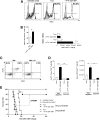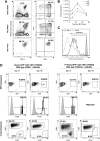Third-party CD4+ invariant natural killer T cells protect from murine GVHD lethality
- PMID: 25795920
- PMCID: PMC4447863
- DOI: 10.1182/blood-2014-11-612762
Third-party CD4+ invariant natural killer T cells protect from murine GVHD lethality
Abstract
Graft-versus-host disease (GVHD) is driven by extensive activation and proliferation of alloreactive donor T cells causing significant morbidity and mortality following allogeneic hematopoietic cell transplantation (HCT). Invariant natural killer T (iNKT) cells are a potent immunoregulatory T-cell subset in both humans and mice. Here, we explored the role of adoptively transferred third-party CD4(+) iNKT cells for protection from lethal GVHD in a murine model of allogeneic HCT across major histocompatibility barriers. We found that low numbers of CD4(+) iNKT cells from third-party mice resulted in a significant survival benefit with retained graft-versus-tumor effects. In vivo expansion of alloreactive T cells was diminished while displaying a T helper cell 2-biased phenotype. Notably, CD4(+) iNKT cells from third-party mice were as protective as CD4(+) iNKT cells from donor mice although third-party CD4(+) iNKT cells were rejected early after allogeneic HCT. Adoptive transfer of third-party CD4(+) iNKT cells resulted in a robust expansion of donor CD4(+)CD25(+)FoxP3(+) regulatory T cells (Tregs) that were required for protection from lethal GVHD. However, in vivo depletion of myeloid-derived suppressor cells abrogated both Treg expansion and protection from lethal GVHD. Despite the fact that iNKT cells are a rare cell population, the almost unlimited third-party availability and feasibility of in vitro expansion provide the basis for clinical translation.
© 2015 by The American Society of Hematology.
Figures






Comment in
-
A party of three: iNKT cells in GVHD prevention.Blood. 2015 May 28;125(22):3374-5. doi: 10.1182/blood-2015-04-636282. Blood. 2015. PMID: 26022054
Similar articles
-
A party of three: iNKT cells in GVHD prevention.Blood. 2015 May 28;125(22):3374-5. doi: 10.1182/blood-2015-04-636282. Blood. 2015. PMID: 26022054
-
CD4+ invariant natural killer T cells protect from murine GVHD lethality through expansion of donor CD4+CD25+FoxP3+ regulatory T cells.Blood. 2014 Nov 20;124(22):3320-8. doi: 10.1182/blood-2014-05-576017. Epub 2014 Oct 7. Blood. 2014. PMID: 25293774 Free PMC article.
-
Donor Requirements for Regulatory T Cell Suppression of Murine Graft-versus-Host Disease.J Immunol. 2015 Jul 1;195(1):347-55. doi: 10.4049/jimmunol.1402861. Epub 2015 May 20. J Immunol. 2015. PMID: 25994967 Free PMC article.
-
Traversing the bench to bedside journey for iNKT cell therapies.Front Immunol. 2024 Aug 7;15:1436968. doi: 10.3389/fimmu.2024.1436968. eCollection 2024. Front Immunol. 2024. PMID: 39170618 Free PMC article. Review.
-
Invariant Natural Killer T Cells As Suppressors of Graft-versus-Host Disease in Allogeneic Hematopoietic Stem Cell Transplantation.Front Immunol. 2017 Jul 31;8:900. doi: 10.3389/fimmu.2017.00900. eCollection 2017. Front Immunol. 2017. PMID: 28824628 Free PMC article. Review.
Cited by
-
Human CD4- invariant NKT lymphocytes regulate graft versus host disease.Oncoimmunology. 2018 Aug 23;7(11):e1470735. doi: 10.1080/2162402X.2018.1470735. eCollection 2018. Oncoimmunology. 2018. PMID: 30377560 Free PMC article.
-
Unedited allogeneic iNKT cells show extended persistence in MHC-mismatched canine recipients.Cell Rep Med. 2023 Oct 17;4(10):101241. doi: 10.1016/j.xcrm.2023.101241. Cell Rep Med. 2023. PMID: 37852175 Free PMC article.
-
Achievement of Tolerance Induction to Prevent Acute Graft-vs.-Host Disease.Front Immunol. 2019 Mar 6;10:309. doi: 10.3389/fimmu.2019.00309. eCollection 2019. Front Immunol. 2019. PMID: 30906290 Free PMC article. Review.
-
Human CD4+ iNKT cell adoptive immunotherapy induces anti-tumour responses against CD1d-negative EBV-driven B lymphoma.Immunology. 2024 Aug;172(4):627-640. doi: 10.1111/imm.13799. Epub 2024 May 13. Immunology. 2024. PMID: 38736328
-
Immune Suppression in Allogeneic Hematopoietic Stem Cell Transplantation.Handb Exp Pharmacol. 2022;272:209-243. doi: 10.1007/164_2021_544. Handb Exp Pharmacol. 2022. PMID: 34628553 Free PMC article.
References
-
- Ferrara JL, Deeg HJ. Graft-versus-host disease. N Engl J Med. 1991;324(10):667–674. - PubMed
-
- Shlomchik WD, Couzens MS, Tang CB, et al. Prevention of graft versus host disease by inactivation of host antigen-presenting cells. Science. 1999;285(5426):412–415. - PubMed
-
- Magenau J, Reddy P. Next generation treatment of acute graft-versus-host disease. Leukemia. 2014;28(12):2283–2291. - PubMed
Publication types
MeSH terms
Grants and funding
LinkOut - more resources
Full Text Sources
Other Literature Sources
Molecular Biology Databases
Research Materials

